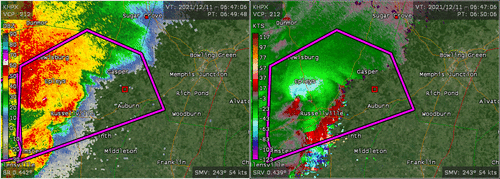000
NOUS44 KMEG 162202
PNSMEG
ARZ009-018-026>028-035-036-048-049-058-MOZ113-115-MSZ001>017-
020>024-TNZ001>004-019>022-048>055-088>092-171015-
Public Information Statement
National Weather Service Memphis TN
402 PM CST Thu Dec 16 2021
...NWS Damage Survey For 12/10/21 Tornado Event...
.OVERVIEW...
This statement summarizes the tornadoes produced by the long-track
supercell storm that moved from western Poinsett County AR, to
Obion County TN, and into Kentucky.
PLEASE NOTE...The information regarding tornado #4 below, from
Craighead County to Obion County, is based on data from ground
surveys. We are continuing to evaluate data from UAS, aircraft, and
satellites regarding the storm`s evolution as it moved through
Obion County. If the data from the supplemental sources reveals
additional critical information, this statement will be updated.
.4: Tornado From Craighead County to Obion County...
Rating: EF-4
Estimated Peak Wind: 170 mph
Path Length /Statute/: 80.3 miles
Path Width /Maximum/: 1800 yards
Fatalities: 5 (1 still missing)
Injuries: Unknown
Start Date: Dec 10 2021
Start Time: 07:07 PM CST
Start Location: 2.9 NNE Bay / Craighead County / AR
Start Lat/Lon: 35.7867 / -90.5511
End Date: Dec 10 2021
End Time: 08:36 PM CST
End Location: 2.6 ENE Samburg / Obion County / TN
End Lat/Lon: 36.3993 / -89.3113
SURVEY SUMMARY: The tornado produced its first damage north of Bay,
damaging storage and outbuildings. The tornado gradually strengthened,
and destroyed a farm tractor storage building along Highway 135
northwest of Lake City. The tornado possibly weakened slightly as it
crossed the St. Francis River area, but re-strengthened as it
approached Monette. Northern and northwestern portions of Monette
suffered significant damage. Homes and retail facilities had their
roofs partially or completely removed, and the roof of a nursing home
partially collapsed. One fatality and at least 5 injuries occurred in
the nursing home.
After leaving Monette, the tornado struck the northern portions of
Leachville, in northwestern Mississippi County. Several homes suffered
partial or complete roof loss in northwestern Leachville. A restaurant,
store, and cotton gin suffered considerable damage along Highway 77, and
numerous power poles were snapped. A fatality occurred in the store.
Anchors to the store`s metal frame were pulled out of the concrete
foundation. The tornado`s path was estimated at nearly a mile wide in
this area.
The tornado then approached the Little River area south of Hornersville,
near the Arkansas/Missouri state line. A stand of trees was debarked
east of Arkansas County Road 243. Several homes and mobile homes were
heavily damaged or destroyed along State Line Road. Additional
debarking of trees was noted. After exiting the Little River area, the
tornado damaged six metal electric transmission line towers. Five of
the towers had their top sections collapse, and one tower completely
collapsed.
The tornado seemed to reach its peak intensity as it moved into
Pemiscot County, Missouri. A home along County Road 454 was substantially
damaged. Farther northeast, near Highway J and County Road 407, two
homes were completely destroyed with debris carried off to the northeast.
A fatality occurred in one of these homes. Several vehicles, including
semi tractor-trailers, were blown off of the road as the tornado
crossed Interstates 55 and 155. Aerial and satellite imagery showed
ground scouring marks in this area across the Mississippi River.
In Lake County, the tornado significantly damaged trees with debarking
southwest of Wynnburg. Homes and shop buildings suffered substantial
damage north of Wynnburg. The tornado approached the Reelfoot Lake
area and caused significant damage to a hotel, convenience store,
restaurant, and camping facilities in the Cypress Point area. Two
fatalities occurred in this area, and one person was still missing as
of December 15. On the southeast shore of Reelfoot Lake, the tornado
damaged cabins and numerous recreational vehicles that were parked in
a storage area.
The tornado`s width was shrinking as it approached Samburg, however,
it was still strong enough to damage homes, businesses, and city
buildings in Samburg. Many homes suffered partial roof loss, and
several mobile homes were separated from their undercarriages. The
tornado continued northeast from Samburg, damaging several homes
along Old Samburg Road. The last observed damage was west of Treece
Road.
.5: Tornado in Western Obion County...
Rating: EF-1
Estimated Peak Wind: 90 mph
Path Length /Statute/: 0.6 miles
Path Width /Maximum/: 100 yards
Fatalities: 0
Injuries: 0
Start Date: Dec 10 2021
Start Time: 08:39 PM CST
Start Location: 5.1 ENE Samburg / Obion County / TN
Start Lat/Lon: 36.4192 / -89.2733
End Date: Dec 10 2021
End Time: 08:40 PM CST
End Location: 5.7 ENE Samburg / Obion County / TN
End Lat/Lon: 36.4236 / -89.2623
SURVEY SUMMARY: A brief tornado uprooted trees along Marvin
Vaught Road northeast of Samburg.
.6: Tornado #2 in Western Obion County...
Rating: EF-0
Estimated Peak Wind: 70 mph
Path Length /Statute/: 0.4 miles
Path Width /Maximum/: 50 yards
Fatalities: 0
Injuries: 0
Start Date: Dec 10 2021
Start Time: 08:43 PM CST
Start Location: 8.9 WNW Union City / Obion County / TN
Start Lat/Lon: 36.4430 / -89.2139
End Date: Dec 10 2021
End Time: 08:44 PM CST
End Location: 8.6 WNW Union City / Obion County / TN
End Lat/Lon: 36.4458 / -89.2078
SURVEY SUMMARY: A brief tornado damaged trees along Highway 22
west of Union City.
.7: Tornado near Shawtown Road in Obion County...
Rating: EF-0
Estimated Peak Wind: 80 mph
Path Length /Statute/: 3.1 miles
Path Width /Maximum/: 80 yards
Fatalities: 0
Injuries: 0
Start Date: Dec 10 2021
Start Time: 08:41 PM CST
Start Location: 6.4 NE Hornbeak / Obion County / TN
Start Lat/Lon: 36.4066 / -89.2241
End Date: Dec 10 2021
End Time: 08:44 PM CST
End Location: 9.5 NE Hornbeak / Obion County / TN
End Lat/Lon: 36.4420 / -89.1901
SURVEY SUMMARY: A tornado damaged trees and storage buildings
along Shawtown Road.

